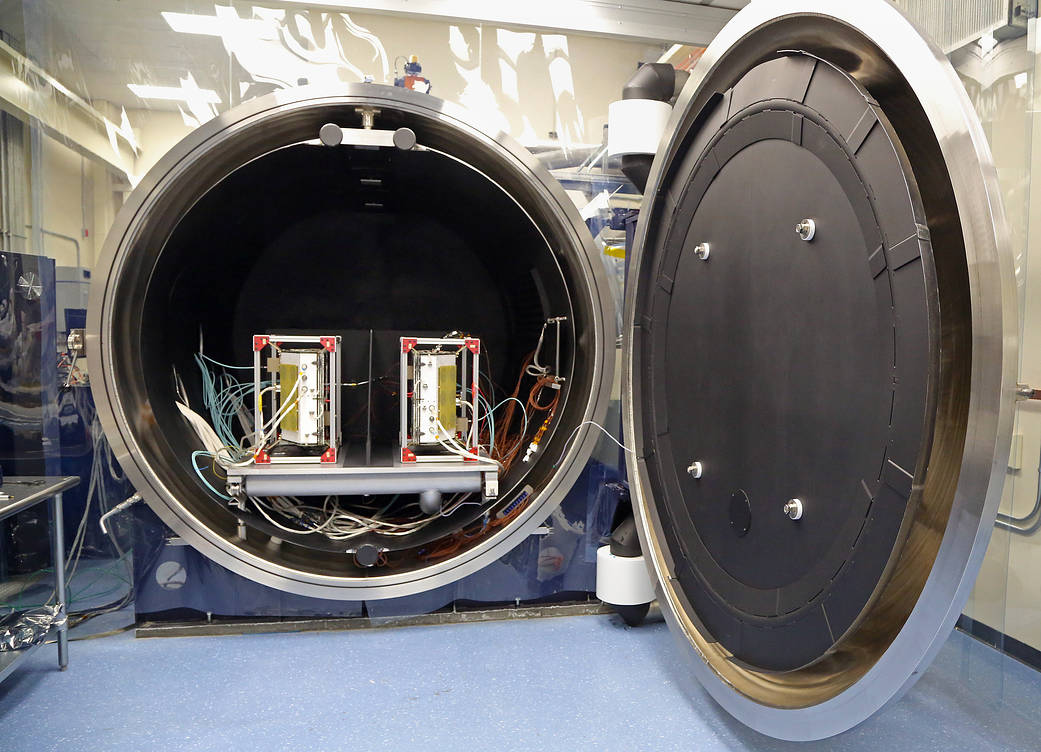NASA’s Cyclone Global Navigation Satellite System (CYGNSS) is one step closer to beginning its mission to probe the inner core of hurricanes in greater detail to better understand their rapid intensification. The first-of-its-kind constellation of eight micro-satellites is undergoing environmental testing at Southwest Research Institute in San Antonio, Texas.
“The CYGNSS team has done a tremendous job of building and integrating all eight spacecraft. Environmental testing is critical to ensuring the constellation will perform as expected in space,” University of Michigan Project Manager Damen Provost says.
Over the next four months, the eight CYGNSS observatories will be subjected to a range of rigorous tests that simulate the vacuum, vibration and extreme temperatures they will experience throughout the life of the mission.
The environmental test phase is an important time in the mission as it will reveal any issues with the microsatellites and instruments before they are launched.
“Environmental testing is the ultimate verification that each of the eight spacecraft will survive and work in space,” said John Scherrer, CYGNSS program manager, of the Southwest Research Institute. “The environmental test campaign concludes with a ‘pre-ship’ review at which NASA authorizes the shipment of CYGNSS to the launch site for integration with the Pegasus rocket.”
Specifically, the CYGNSS observatories will undergo tests to simulate the harsh environments of space and launch, including separation and deployment, vibration, and electromagnetic interference. Additionally, all of the spacecraft will be placed in a vacuum chamber and cycled through the extreme hot and cold temperatures they will face in orbit. Once the spacecraft have completed the full array of environmental tests, they will be transported to Vandenberg Air Force Base to be mated with the launch vehicle.
“It has been exciting to see the spacecraft perform in these tests and corroborate the computer models we used to design them,” said Dr. Jon Van Noord, Lead Mechanical Engineer from University of Michigan who designed the thermal control of the spacecraft.
The goal of CYGNSS is to improve hurricane intensity forecasts. The instrument aboard the eight CYGNSS spacecraft will measure surface winds in and near the inner core of hurricanes, including regions within the eye wall and intense inner rainbands that could not previously be measured from space. The CYGNSS-measured wind fields, when combined with precipitation fields (e.g., produced by the Global Precipitation Measurement core satellite and its constellation of precipitation imagers), will provide coupled observations of moist atmospheric thermodynamics and ocean surface response, enabling new insights into hurricane inner core dynamics and energetics.
CYGNSS will launch in October 2016 from Cape Canaveral Air Force Station in Florida aboard a Pegasus XL rocket from an Orbital ATK Stargazer L-1011 aircraft. CYGNSS is funded by NASA’s Earth Science Division through its Earth System Science Pathfinder Program Office and developed by the University of Michigan.
Credit: SwRI




























